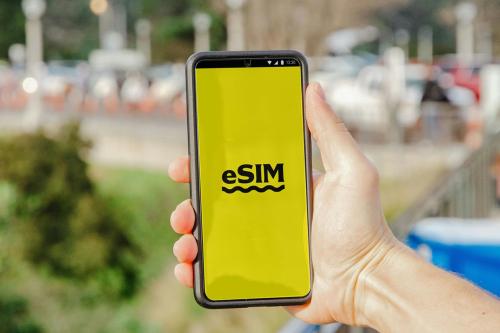Thanks to eSIMs, travelers can stay connected while traveling more easily than ever. As anyone who has hopped from one country to another knows, managing multiple SIM cards can be difficult. What’s the good news? You no longer have to worry about those hassles with an eSIM. You do not need any technical knowledge in order to set up an eSIM on Android with this guide.
It is my intention to share my personal experiences, key insights, and steps-by-step instructions for setting up an eSIM on Android in this post. It will include pros and cons, costs and providers options, as well as a few travel anecdotes to keep things interesting as well.
The benefits of eSIMs when it comes to traveling
With instant connectivity, there is no more need to wait or hunt for a local SIM card.
Reduces the need for disposable plastic SIM cards, which are environmentally friendly.
Coverage across more than one country: Great for regions with a lot of cross-border travel.
It is possible to monitor your usage in real time using many apps that offer seamless data management.
Why Should You Use an eSIM and What Are the Benefits of Using One?
It is important to understand that an eSIM (embedded SIM) is a digital version of a physical SIM card. In contrast to inserting a plastic SIM card into your Android device, the eSIM is embedded directly into your Android device and does not need to be removed. In this way, you will be able to activate a cellular plan without having to have a physical SIM card. In order to demonstrate why eSIMs are a game-changer, especially when it comes to frequent travelers, here are a few reasons:
“I first discovered eSIMs on a recent trip through Southeast Asia. I was tired of dealing with flimsy SIM cards at every border, so I switched to an eSIM with a local provider. The difference was night and day—I could swap between networks seamlessly without touching my phone’s hardware.”
The most important takeaways
The convenience of switching carriers and plans with the click of a button.
There are eSIMs that cover multiple countries, which is great for globetrotters as some eSIMs cover multiple countries at the same time.
As a result, the need for physical SIM cards is eliminated, which reduces plastic waste.
Getting started with an eSIM on Android: Steps to follow
An eSIM might seem intimidating at first, but the process of setting up an eSIM is actually quite simple. It is simply a matter of making sure your Android device supports eSIM functionality (most newer models from Google Pixel, Samsung, and Huawei do so).
The first step is to check the compatibility of your device
It is important to confirm before going any further that your Android smartphone supports eSIM. The following is a quick table of the most popular Android models that are compatible with eSIM:
| Brand | Models |
|---|---|
| Google Pixel | Pixel 3 and newer (except Pixel 3a) |
| Samsung | Galaxy S20 and newer, Galaxy Z Flip, Note 20 |
| Huawei | Huawei P40 and Mate 40 series |
“When I upgraded to a Pixel 6, the eSIM setup became part of my travel routine. No more waiting at kiosks for a SIM card. Now, a quick scan and I’m ready to go!”
The second step in setting up an eSIM is to choose a provider
As far as eSIM providers are concerned, there are many of them to choose from. In order to give you a better idea of the costs involved, here are a few popular choices:
| Provider | Cost | Coverage |
|---|---|---|
| Airalo | $5+ per GB | Over 190 countries |
| Nomad | $10+ per GB | Worldwide |
| GigSky | $10+ for 1GB (1 day) | 190+ countries |
| Truphone | Custom plans available | 80 countries |
Almost all of these providers offer an app that you can download and use to activate the eSIM, which makes the process of activating it even easier.
The third step in the process is to purchase and install the eSIM card
In order to buy an eSIM plan, you need to open your provider’s app (e.g., Airalo, Nomad, GigSky) and choose the appropriate plan for your needs. You will receive a QR code once you have completed the purchase process.
On an Android device, open the eSIM Settings by following these steps:
To access the Mobile Network settings, go to Settings > Network & Internet > Mobile Network.
Click on Add Carrier and then select Scan QR Code to add the carrier.
The QR code can be scanned using your phone’s camera by using the QR code provided by the provider of the eSIM service. In a matter of seconds, the eSIM will be downloaded and activated.
“I remember sitting in a cafe in Bali, scanning my eSIM QR code with Nomad. It was a relief knowing I’d be connected as soon as I walked out. It felt like a small victory in the world of solo travel!”
The fourth step is to activate the eSIM card and configure the settings
As soon as your new eSIM is installed, you need to go back to your Network Settings and select your new eSIM as the preferred data source. When using an eSIM, you can usually name it in order to keep track of which country or provider you are using at the moment, which is handy if you travel a lot.
Pros and Cons of Using an eSIM on Android
While eSIMs are fantastic for convenience and flexibility, they come with a few caveats worth noting.
| Pros | Cons |
|---|---|
| Quick setup and activation | Not available on all Android devices |
| Easy switching between carriers | Limited availability in some countries |
| Reduces the need for physical SIM cards | Some carriers may have restricted plans |
| Great for frequent travelers | May be more costly than local SIMs |
Frequently Asked Questions
Q: Can I use an eSIM and a physical SIM simultaneously?
A: Yes, most Android devices support dual SIM functionality, so you can use an eSIM and a physical SIM at the same time. This is especially handy if you want to keep your home number active while traveling.
Q: Do I need Wi-Fi to activate my eSIM?
A: Yes, you’ll need a Wi-Fi connection to download the eSIM profile initially. After activation, you can use cellular data as usual.
Q: Is an eSIM more expensive than a traditional SIM?
A: It depends. While local physical SIMs are often cheaper, eSIMs can offer more flexibility, especially if you’re crossing multiple borders.
Q: Are there any data restrictions on eSIMs?
A: Some eSIM plans come with data limits, while others offer unlimited options. Be sure to read the terms from your provider before purchasing.
Q: How do I remove or delete an eSIM?
A: Go to Settings > Network & Internet > Mobile Network. Find your eSIM profile, then select Delete.
What are the benefits of using an eSIM when traveling?
In case you are a frequent traveler, switching to an eSIM is definitely something you should try. As a result, it has become possible to choose a local carrier at the touch of a button, which is a game-changer.
“Using an eSIM throughout my last trip across Europe saved me hours of fuss. I no longer had to hunt down a local SIM vendor—one scan was all it took. Plus, I could manage everything in-app, from data to account balance. It’s been a complete game-changer.”
Are eSIMs Right for You: My Final Thoughts: Should You Consider an eSIM?
With an eSIM on Android, it is a convenient and flexible solution that meets the needs of today’s connected travelers. You might just find that your new travel buddy is an eSIM, as they are able to hop between networks seamlessly, manage data efficiently, and eliminate the hassle of physical SIM cards.
“As someone who’s always on the move, an eSIM has become a must-have in my travel toolkit. It’s that perfect blend of convenience, simplicity, and control—all wrapped up in a digital package.”









